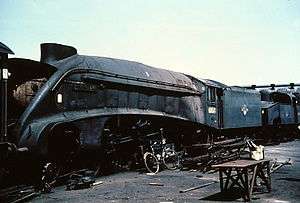LNER Class A4 2509 Silver Link
Silver Link was the first London and North Eastern Railway (LNER) A4 Class locomotive, built in 1935 to pull a new train called the Silver Jubilee.
| Silver Link | |||||||||||||||||||||||||||
|---|---|---|---|---|---|---|---|---|---|---|---|---|---|---|---|---|---|---|---|---|---|---|---|---|---|---|---|
 Silver Link at Doncaster Works in March 1963, shortly before it was broken up for scrap | |||||||||||||||||||||||||||
| |||||||||||||||||||||||||||
| |||||||||||||||||||||||||||
| |||||||||||||||||||||||||||
| |||||||||||||||||||||||||||
History
Silver Link made its inaugural journey from King's Cross on 29 September 1935. It reached a speed of 112 miles per hour (180 km/h), breaking all previous records. The record provoked the LNER and their chief rival the London, Midland and Scottish Railway (LMS) into a highly competitive speed war, each attempting to outdo the other by building ever faster locomotives. The main protagonists were Sir Nigel Gresley, LNER's chief mechanical engineer, and his counterpart at LMS, Sir William Stanier.
Silver Link was so named after a line in a poem about love by Sir Walter Scott, which reads:
True love's the gift which God has given
To man alone beneath the heaven;
It is not fantasy's hot fire,
Whose wishes, soon as granted, fly;
It liveth not in fierce desire,
With dead desire it doth not die;
It is the secret sympathy,
The silver link, the silken tie,
Which heart to heart, and mind to mind,
In body and in soul can bind.[1]
Allocated to Kings Cross shed, it was withdrawn from service on 29 December 1962 when the East Coast Main Line express services were taken over by Deltic diesel locomotives. It was not preserved after withdrawal and was broken up for scrap at Doncaster Works on 7 September 1963, on the same site where it had been built nearly twenty eight years earlier.[2][3]
Two instances of the Silver Link nameplate are on display at the National Railway Museum, York, UK.[4]
References
- Boddy, M.G.; Neve, E.; Yeadon, W.B. (April 1973). Fry, E.V. (ed.). Locomotives of the L.N.E.R., part 2A: Tender Engines - Classes A1 to A10. Kenilworth: RCTS. p. 134. ISBN 0-901115-25-8.CS1 maint: ref=harv (link)
- http://railwayphotoprints.co.uk/image/detail/41%5B%5D
- National Railway Museum, object number: 1975-7609